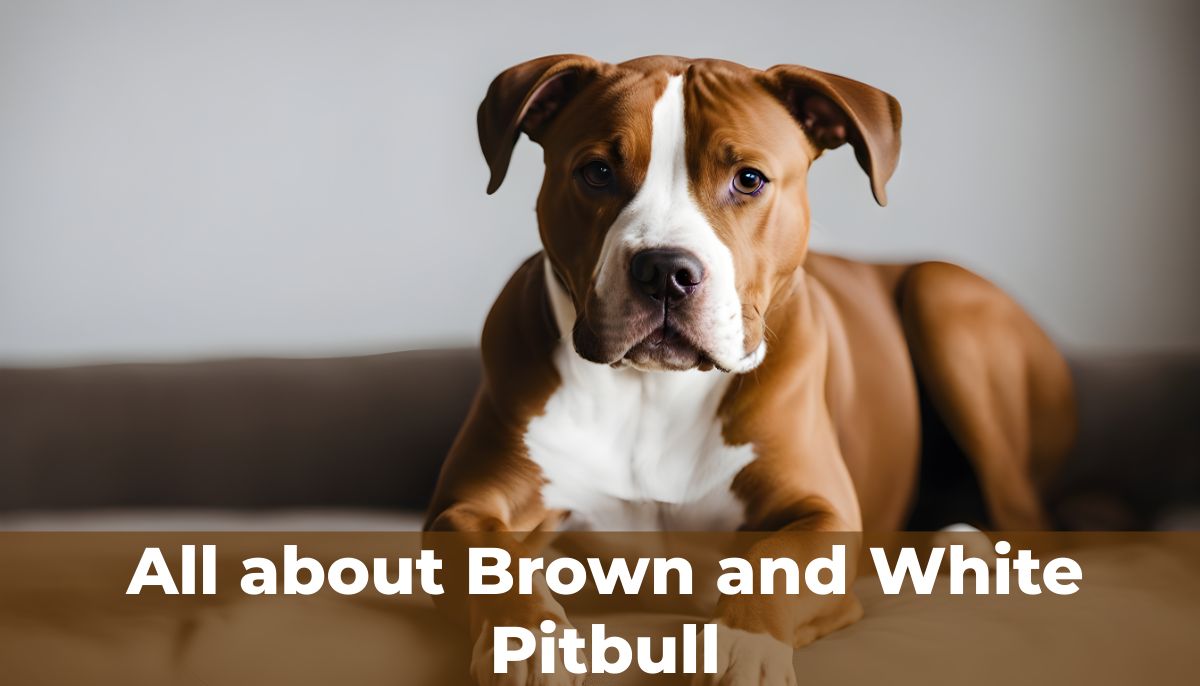Curious about those charming white-brown Pitbulls? Well, you’re not alone! I’m here to inform you about these lovely dogs. You see, I’m not just some random writer; I’m a proud Pitbull owner and enthusiast. I’ve spent years getting to know these incredible pups inside and out.
So, if you have Ever wondered why some brown-white Pits seem to have an irresistible charm, you are at the right place. In this article, I’ll share all the nitty-gritty details about brown and white Pitbull straight from the perspective of someone who adores them.
Appearance:
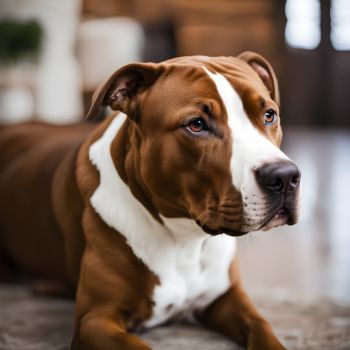
Brown and white pitbull terriers have short, shiny coats that can be any shade of brown, from light tan to dark chocolate.
You might notice that some parts of their fur are brown while others are white.
Their white markings can be in any pattern, from small patches to large patches or a completely white base coat with brown spots.
They have a big head with a square jaw and expressive eyes. Their ears stand straight, and their tail is a bit long and tapers down to a point.
Brown-white pit bulls have a very friendly and alert face, which makes them look handsome.
Brown white pitbulls are medium to large dogs, with males typically weighing between 35 and 65 pounds and females weighing between 30 and 60 pounds. They stand between 18 and 21 inches tall at the shoulder.
They shed moderately and require only occasional brushing and bathing. They are not very big dogs, but they are solid and sturdy. Their chest is broad, and their legs are strong.
You’ll often see them with a white chest and white paws, while the rest of their body can be brown or have brown patches. When thinking of brown-white pitbull names, you can consider their unique coat patterns and personalities.
Genetics of Brown White Pitbull:
Eumelanin and Pheomelanin: The colors in a Pitbull’s coat come from two types of pigments: eumelanin (black and brown) and pheomelanin (red and yellow).
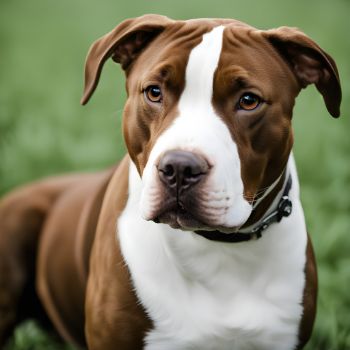
Brown color in these Pitbulls results from eumelanin, while white is due to a lack of pigments in some areas.
Agouti Signaling Protein (ASIP) Gene: The ASIP gene plays a crucial role in determining the distribution of these pigments. It decides where the eumelanin (brown) and pheomelanin (red) will appear on the dog’s coat.
Melanocortin 1 Receptor (MC1R) Gene: The MC1R gene is responsible for the brown color in brown white Pitbulls. It controls the production of eumelanin, and a specific variation of this gene results in the brown coloration.
S-locus Gene: The S-locus gene produces a white color in dogs. Different versions of this gene determine how much white is in a dog’s coat. In the case of brown and white Pitties, there’s often a balance between brown and white due to the interaction of these genes.
The combination and interaction of these genes and pigment factors in each Pitbull create the unique brown and white patterns we see in their coat.
Popularity of this coloration:
It is a popular color combination among pitbull owners. It is considered to be a classic pitbull color, and it is often associated with the breed’s muscular build and playfulness.
According to a recent survey of pitbull owners, brown and white is the second most popular color, after fawn or brown.
It is also one of the most popular pitbull colors on social media, with #brownandwhitepitbull having over 250,000 posts on Instagram.
Here are some of the reasons why brown and white pitbulls are so popular:
- They are eye-catching. These pit bulls have a unique and distinctive appearance. Their two-tone coats are sure to turn heads wherever they go.
- They are versatile. These dogs can have a variety of different coat patterns, from small patches to large patches or even a completely white base coat with brown spots. It makes them versatile dogs, as they can easily fit in with any family or lifestyle.
- They are easy to care for. Brown white pits have short, low-maintenance coats that require only occasional brushing and bathing.
- They have great personalities. White-brown pitbulls are known for their friendly and outgoing personalities. They are typically good with children and other pets, and they make great companions for active families and individuals.
Brown and white Pitbull with blue eyes:
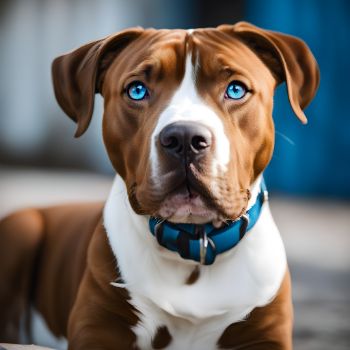
A recessive gene causes the blue eye color in white and brown pit bulls, called the merle gene. The merle gene dilutes the eumelanin pigment in the fur and skin, resulting in various colors and patterns, including blue eyes.
To have blue eyes, a brown-white pit must have two copies of the Merle gene. If a pitbull has one copy of the Merle gene and one copy of the non-merle gene, it may have brown or brindle eyes with blue dots.
If a pitbull has two copies of the non-merle gene, it will have brown or brindle eyes without any blue. The blue eye color is not exclusive to Pitbull with Brown and White fur coat
It can also be found in other breeds, such as Australian Shepherds, Border Collies, and Dachshunds. However, it is less common in pitbulls.
Coat Color and Markings:
American pit bull Brown and white can have various coat colors and markings.
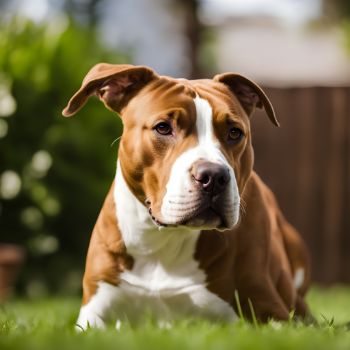
Brown Shades: These dogs can have different shades of brown in their coat. Some may have a deep, dark brown color, while others may have a lighter, milk chocolate brown. This variation in brown shades adds to their individuality.
White Markings: The white markings on Pitbull brown and white are just as important as the brown. These white patches can be found on their chest, paws, face, and sometimes on their belly. It’s common to see a white chest, white paws, or even a white blaze on their face.
Patterns: Some Pitbulls may have a white blaze running down their face, resembling a “kiss” mark on the forehead. Others may have white socks on their legs or a white-tipped tail.
Uniformity: The distribution of brown and white is usually quite uniform. You might notice that one side of the dog’s face or body mirrors the other side, creating a balanced and symmetrical look.
Solid Color Areas: Sometimes, you’ll find solid brown areas on a brown and white Pitbull dog. These solid brown patches can be on their ears, back, or sides. These patches create a striking contrast with the white areas.
Pitbull Dog Dark Brown and White:
Dark brown and white Pittie has a striking deep brown coat almost like rich chocolate. Here’s what makes them look so cool:
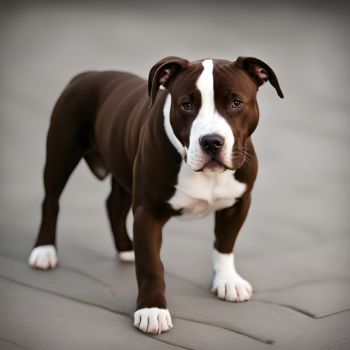
Dark Brown Coat: These Pitbulls rock a deep and intense brown coat that stands out against the white parts.
White Markings: The white patches on their dark brown fur are super bright and clear. They’re often found on their chest, paws, faces, and a few other spots, making for an eye-catching combo.
Clear Patterns: Check out the patterns on these dogs – they’re sharp and easy to spot. The line where the brown meets the white is well-defined, adding to their unique and attractive look.
Symmetry: Just like their light brown pals, dark brown and white terriers often have a balanced and symmetrical look. It’s part of what makes them so darn good-looking.
Pitbull Dog Light Brown and White:
Light brown and white Pitbull puppy is all about that warm and inviting soft brown fur. Here’s what’s cool about their appearance:
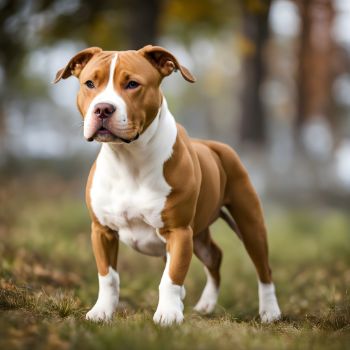
Light Brown Coat: Their light brown color is cozy and welcoming. It’s like a gentle hug for your eyes and offers a soft contrast to the white areas.
White Markings: Those white patches on their light brown coat give them a soft and charming vibe. You’ll often find them on their chest, paws, face, and maybe a few other spots.
Subtle Patterns: The patterns on these Pitbulls are more low-key than the darker ones. The transition from brown to white is smoother, adding to their charm.
Symmetry: Like their dark brown buddies, light brown and white terriers usually have a nicely balanced look. It’s part of what makes them so easy on the eyes.
Distinctive Features and Variations:
Brown and white American Pitbull Terriers are known for their unique appearance, with specific features and variations.
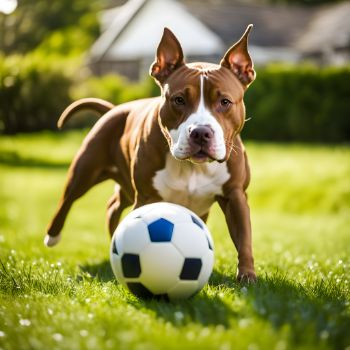
- Eye color: These pitbulls can have brown, black, blue, or amber eyes. Dogs with a lot of white on their face, such as a white blaze or white markings around the eyes, are more likely to have blue or amber eyes.
- Nose color: Brown and white pitbull terriers can have black, brown, or red noses. Dogs with a lot of brown on their face, such as a brown brindle coat or brown spots on the face, are more likely to have a black or brown nose.
- Mask: Some pitbull dogs, white and brown, have a mask, which is a solid color area around the eyes and nose. The mask is typically the same color as the dog’s dominant coat color, but it can also be a different color.
Coat Color Influence on Temperament:
There is no scientific evidence to suggest that coat color influences the temperament and behavior of brown and white pitbulls or any other breed of dog.
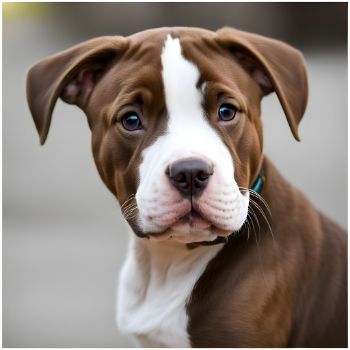
Temperament and behavior are primarily determined by genetics, socialization, and training. However, some believe specific coat colors are associated with certain temperaments.
For example, some believe brown and white Bull Terriers are more gentle and affectionate than other pitbull colors. Others believe that brown white pitbulls are more aggressive than different pitbull colors.
These beliefs are likely based on stereotypes and personal experiences. There is no evidence to suggest that pitbull dog brown and white is more or less likely to be gentle or aggressive than any other color.
Brown and white pitbull terriers are known for being friendly, affectionate, and playful dogs. Pitbulls are often misunderstood as aggressive dogs, but this is untrue.
Health Concerns:
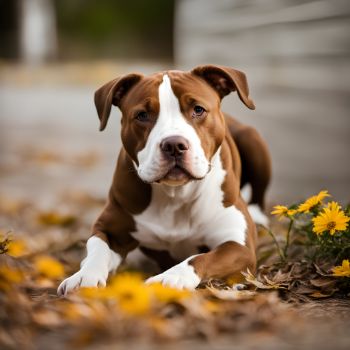
Brown and white bull terriers are generally healthy dogs, but they are prone to some of the same health concerns.
Skin cancer: White and brown pits are at increased risk for skin cancer due to their light-colored fur. White fur does not protect the skin from the sun’s harmful UV rays.
To protect your brown and white pitbull from skin cancer, be sure to apply sunscreen to their skin when they are outdoors, especially on their ears, nose, and belly.
Allergies: White-brown Pitbulls may be more prone to skin allergies. The lighter areas of their coat may be more sensitive.
Myths and Facts:
Myth: White and brown pit bulls are likelier to be deaf than other dogs.
Fact: There is no scientific evidence to support this claim. Deafness is a genetic condition in any dog breed, regardless of coat color.
Evidence to dispel this myth:
A study conducted at the University of California, Davis and the University of Missouri, Columbia in 2018 was published in the journal “Veterinary Dermatology.”
They examined over 1,000 pit bulls of all coat colors and found no evidence that any particular color was associated with an increased risk of deafness.
Brown and White Pitbull Puppies:
White and brown pitbull puppy is a popular color variation of the pitbull terrier breed. These are known for their gentle and affectionate nature, as well as their playful and energetic personalities.
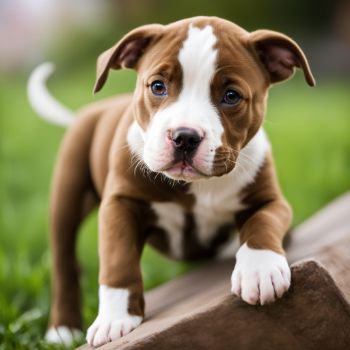
Puppies can have a variety of different coat colors and markings. The brown color can vary from light to dark shades, often resembling rich chocolate or coffee.
The white areas create a striking contrast, typically appearing on the chest, paws, face, and sometimes other body parts.
Some puppies may have a solid brown coat with white markings on their paws, chest, and face. Others may have a brindle coat with white markings. Still others may have a white base coat with brown spots.
While brown is the dominant color, white markings may be seen in various patterns. Common patterns include “Irish Markings,” where a white blaze runs down the face or chest, and “Socks,” which are white patches on the legs.
“Masks” are another pattern, with white fur around the eyes or mouth. Some puppies may have a lot of white fur, while others may have little.
White and brown pitbull puppies are recognized by all major kennel clubs, including the American Kennel Club (AKC), the United Kennel Club (UKC), and the Canadian Kennel Club (CKC). They are also eligible to compete in all AKC-sanctioned events.
Red Nose Pitbull White and Brown:
The red nose variation in Pitbulls is believed to have originated in Ireland in the early 1800s. These dogs were bred for their working abilities, such as hunting, farming, and herding livestock.
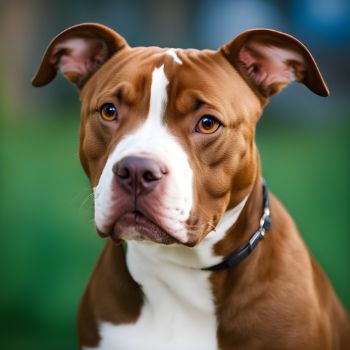
In the mid-1900s, Irish immigrants brought the red-nosed Pitbull to the United States, where it quickly became a popular breed.
The primary genes in red nose coloration are the “E” and the “B” locus.
The “E” locus controls the production of eumelanin (black pigment) and phaeomelanin (red pigment). The “E” gene can result in a red or black coat color.
The “B” locus determines the distribution of eumelanin. The “B” gene can lead to the brown or black coat color. When combined with the “E” gene, it results in a red (phelomelanic) and brown (eumelanic) coat, which is the hallmark of this brown and white pitbull.
The red nose color in these Pitbulls is attributed to reduced eumelanin pigmentation in their nose and eye rims.
The “d” gene, known as the dilution gene, dilutes black pigments, leading to the red or liver coloration of the nose and eye rims. This genetic trait is responsible for the distinctive red noses seen in these Pitbulls.
FAQs
What colors do puppies have if one parent is brown and white and the other is blue and white?
The puppies may have a mix of brown and white, blue and white, or various color combinations.
What kind of pitbull is brown and white?
Pitbulls with a brown and white coat can be American Pit Bull Terriers, a common breed variation.
What are brown and white pitbulls called?
Pitbulls with brown and white markings are often called “American Pit Bull Terriers” or simply “brown and white Pitbulls.”
Conclusion:
Brown white Pit bulls are friendly and lovely dogs. Their coat colors, with brown and white patches, make them look unique. Remember, their coat color doesn’t affect their loving nature.
Whether you choose to adopt or breed, responsible care and love are what matters most. Always treat them with love and care, and they’ll be your loyal pals for life!

